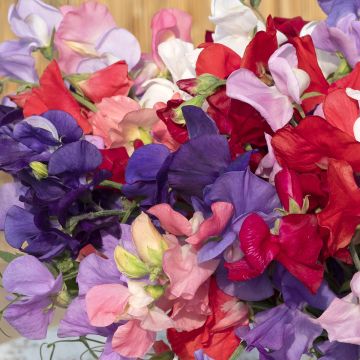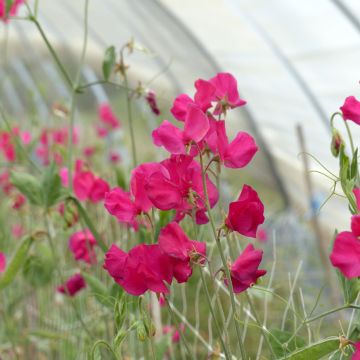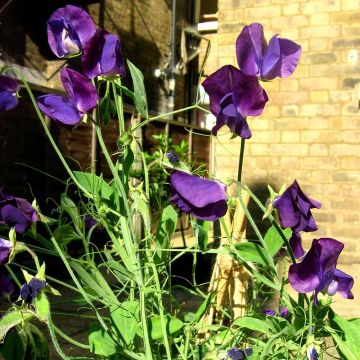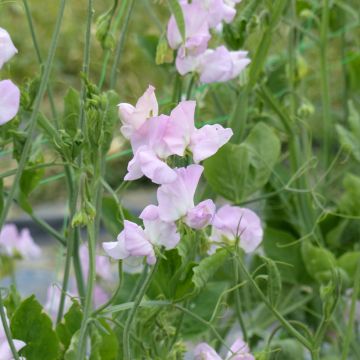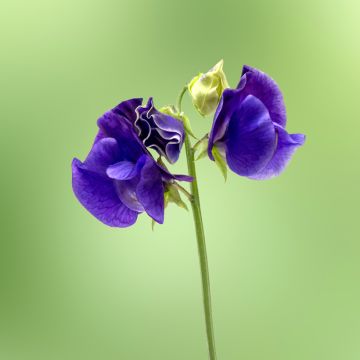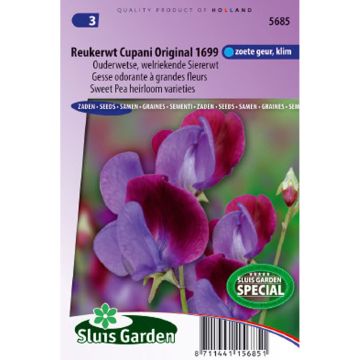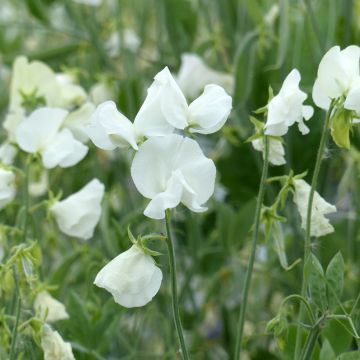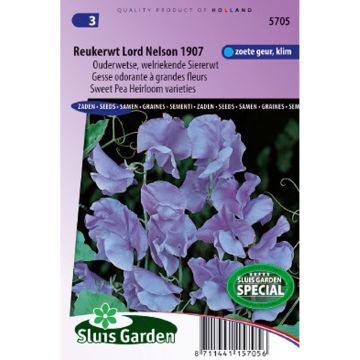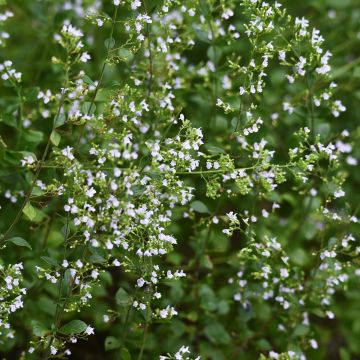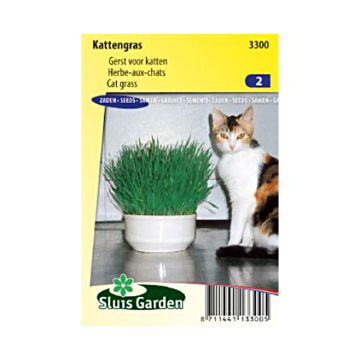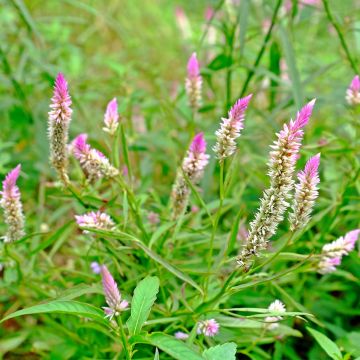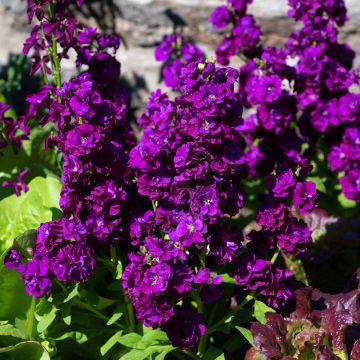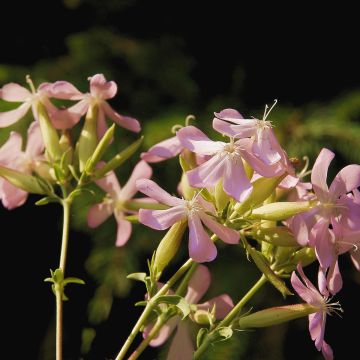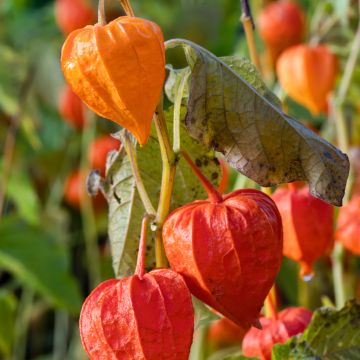

Lathyrus odoratus Zorjia Rose - Sweet Pea Seeds
Lathyrus odoratus Zorjia Rose - Sweet Pea Seeds
Lathyrus odoratus grandiflora Zorjia Rose
Sweet Pea, Vetch, Vetchling
This item cannot be shipped to the selected country
Dispatch by letter from €3.90
More information
Schedule delivery date,
and select date in basket
This plant carries a 6 months recovery warranty
More information
We guarantee the quality of our plants for a full growing cycle, and will replace at our expense any plant that fails to recover under normal climatic and planting conditions.
Seed-only orders are dispatched by sealed envelope. The delivery charge for seed-only orders is €3.90.
Does this plant fit my garden?
Set up your Plantfit profile →
Description
'Zorjia Rose’ is a recent sweet pea variety that has already proven it’s worth thanks to its stunning clusters of intense pink-violet blooms. This abundantly flowering and delicately fragrant sweet pea has medium-sized flowers that don’t fade in the sunlight. Its long, sturdy, voluble stems that grow to 1.75 m in height for 30 cm in width. The plants cover up their support in no time and are beautiful when used as a ground cover. In hanging baskets, they will romantically cascade down in exquisite garlands. The cut flowers are perfect for bouquets. Flowering takes places from June to August. Grow in a sunny location in fertile, moist soil.
Lathyrus odoratus is an annual herbaceous plant of the Fabaceae family originating from south-eastern Italy and Sicily. It can reach 1.80 m to 2.50 m in height and 30 cm in width in the space of a few months. Its quadrangular winged stems have stipules at their base, bear pairs of light-green leaflets and end in a terminal tendril. Flowering takes place from May to October depending on the variety. The papilionaceous flowers are grouped in axillary clusters. The flowers are composed of 5 petals: a standard, 2 free wing petals, and 2 fused petals. They give off a delightful fragrance, which has a sweet floral aroma with honeyed and musky notes. The fruit is a flat pod that splits at maturity, forcibly expelling its seeds away from the plant. It is essential to regularly remove wilted flowers, as seed production stunts flowering. Sweet peas root deeply in the ground to find water and nutrients.
Sweet peas are irreplaceable, their charming and old-fashioned flowers make quaint bouquets, look stunning in hanging baskets will soon cover up an old garden wall or fence. They are beautiful in summer flower beds, where they will use neighbouring plants or shrubs as a support. They can also form colourful carpets when grown as ground cover. Sweet peas are a must-have in cottage gardens alongside peonies, hollyhocks, fox gloves, peach leaved bellflowers, and columbines. They also do well in the fertile and well-watered soil of the vegetable garden, where they can be used as cut flowers.
Report an error about the product description
Flowering
Foliage
Plant habit
Botanical data
Lathyrus
odoratus grandiflora
Zorjia Rose
Fabaceae
Sweet Pea, Vetch, Vetchling
Cultivar or hybrid
Other Sweet Pea seeds
Planting and care
Before sowing them, let the seeds soak in a bowl of water for 6 hours. This will improve the germination speed.
Sow Sweet Peas directly in place at the base of a trellis in March-April, in a small hole (group of 2 or 3 seeds) at a depth of 2.5 cm. Leave a minimum distance of 30 cm between two holes.
When the seedlings have reached the stage of the second pair of leaves, cut the tip of each stem to promote branching.
Regular watering without excess will accelerate its growth. A sunny location, a supply of fertilizer for flowering plants, and the removal of faded flowers will promote abundant flowering from June to August.
Beware of snails and slugs that love to devour young plants.
Sowing period
Intended location
This item has not been reviewed yet - be the first to leave a review about it.
Flower seeds
Haven't found what you were looking for?
Hardiness is the lowest winter temperature a plant can endure without suffering serious damage or even dying. However, hardiness is affected by location (a sheltered area, such as a patio), protection (winter cover) and soil type (hardiness is improved by well-drained soil).

Photo Sharing Terms & Conditions
In order to encourage gardeners to interact and share their experiences, Promesse de fleurs offers various media enabling content to be uploaded onto its Site - in particular via the ‘Photo sharing’ module.
The User agrees to refrain from:
- Posting any content that is illegal, prejudicial, insulting, racist, inciteful to hatred, revisionist, contrary to public decency, that infringes on privacy or on the privacy rights of third parties, in particular the publicity rights of persons and goods, intellectual property rights, or the right to privacy.
- Submitting content on behalf of a third party;
- Impersonate the identity of a third party and/or publish any personal information about a third party;
In general, the User undertakes to refrain from any unethical behaviour.
All Content (in particular text, comments, files, images, photos, videos, creative works, etc.), which may be subject to property or intellectual property rights, image or other private rights, shall remain the property of the User, subject to the limited rights granted by the terms of the licence granted by Promesse de fleurs as stated below. Users are at liberty to publish or not to publish such Content on the Site, notably via the ‘Photo Sharing’ facility, and accept that this Content shall be made public and freely accessible, notably on the Internet.
Users further acknowledge, undertake to have ,and guarantee that they hold all necessary rights and permissions to publish such material on the Site, in particular with regard to the legislation in force pertaining to any privacy, property, intellectual property, image, or contractual rights, or rights of any other nature. By publishing such Content on the Site, Users acknowledge accepting full liability as publishers of the Content within the meaning of the law, and grant Promesse de fleurs, free of charge, an inclusive, worldwide licence for the said Content for the entire duration of its publication, including all reproduction, representation, up/downloading, displaying, performing, transmission, and storage rights.
Users also grant permission for their name to be linked to the Content and accept that this link may not always be made available.
By engaging in posting material, Users consent to their Content becoming automatically accessible on the Internet, in particular on other sites and/or blogs and/or web pages of the Promesse de fleurs site, including in particular social pages and the Promesse de fleurs catalogue.
Users may secure the removal of entrusted content free of charge by issuing a simple request via our contact form.
The flowering period indicated on our website applies to countries and regions located in USDA zone 8 (France, the United Kingdom, Ireland, the Netherlands, etc.)
It will vary according to where you live:
- In zones 9 to 10 (Italy, Spain, Greece, etc.), flowering will occur about 2 to 4 weeks earlier.
- In zones 6 to 7 (Germany, Poland, Slovenia, and lower mountainous regions), flowering will be delayed by 2 to 3 weeks.
- In zone 5 (Central Europe, Scandinavia), blooming will be delayed by 3 to 5 weeks.
In temperate climates, pruning of spring-flowering shrubs (forsythia, spireas, etc.) should be done just after flowering.
Pruning of summer-flowering shrubs (Indian Lilac, Perovskia, etc.) can be done in winter or spring.
In cold regions as well as with frost-sensitive plants, avoid pruning too early when severe frosts may still occur.
The planting period indicated on our website applies to countries and regions located in USDA zone 8 (France, United Kingdom, Ireland, Netherlands).
It will vary according to where you live:
- In Mediterranean zones (Marseille, Madrid, Milan, etc.), autumn and winter are the best planting periods.
- In continental zones (Strasbourg, Munich, Vienna, etc.), delay planting by 2 to 3 weeks in spring and bring it forward by 2 to 4 weeks in autumn.
- In mountainous regions (the Alps, Pyrenees, Carpathians, etc.), it is best to plant in late spring (May-June) or late summer (August-September).
The harvesting period indicated on our website applies to countries and regions in USDA zone 8 (France, England, Ireland, the Netherlands).
In colder areas (Scandinavia, Poland, Austria...) fruit and vegetable harvests are likely to be delayed by 3-4 weeks.
In warmer areas (Italy, Spain, Greece, etc.), harvesting will probably take place earlier, depending on weather conditions.
The sowing periods indicated on our website apply to countries and regions within USDA Zone 8 (France, UK, Ireland, Netherlands).
In colder areas (Scandinavia, Poland, Austria...), delay any outdoor sowing by 3-4 weeks, or sow under glass.
In warmer climes (Italy, Spain, Greece, etc.), bring outdoor sowing forward by a few weeks.


































